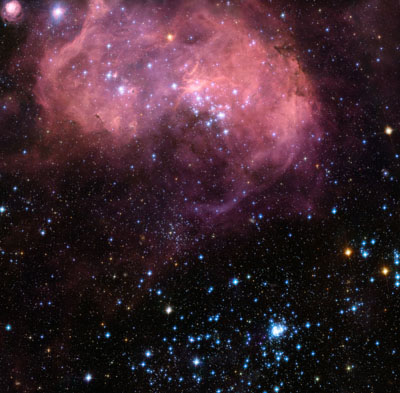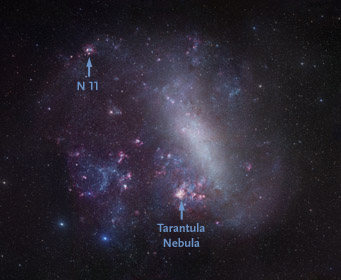Some of the night sky's most spectacular nebulas involve giant clouds of hydrogen gas (termed H II regions), where massive young stars have illuminated their surroundings with intense, ultraviolet-rich light. Once ionized, the gas glows with the unmistakable crimson of hydrogen-alpha emission at a wavelength of 656 nm.
Many of these brilliant cotton-candy whorls lie not in the Milky Way proper but rather 160,000 light-years away in the Large Magellanic Cloud.

A cocoon of young stars and gas clouds informally known as N 11 (the Bean Nebula) lies 160,000 light-years away in the Large Magellanic Cloud. This portion of it, about 6 arcminutes across, was captured with the Hubble Space Telescope’s Advanced Camera for Surveys. Click here for a larger view.
NASA / ESA / J. M. Apell?°niz
A stunning example is LHA 120-N 11, known more informally as N 11 or the Bean Nebula. It ranks as the second largest star-forming region in the LMC, behind 30 Doradus, the Tarantula Nebula. (Historical footnote: LHA 120-N 11 was first cataloged in 1956 by the late Karl Henize, an astronomer-turned-astronaut.)
Recently Jesús Maíz Apellániz (Astrophysics Institute of Andalucía, Spain) used the Hubble Space Telescope's Advanced Camera for Surveys to capture this stunning, 6-arcminute-wide portion of the much-larger nebula.
It beautifully illustrates the sequence of events that occurs in such regions. Near the bottom is a cluster massive blue-white stars, spectral types O and B, whose stellar winds and radiation have pushed away the residual gas to create a relatively clear pocket. As this ejected gas moves outward, it collides with surrounding dense clouds, causing them to collapse and start to form new stars. These newborns then light up their surroundings.

The star-forming region N 11 is located on the northwest edge of the Large Magelleanic Cloud, where its second in size only to the Tarantula Nebula. Click here for a larger version.
Robert Gendler
This isn't the first time astronomers have targeted N 11 with HST. A series of images taken in 1999 with the observatory's Wide Field Planetary Camera 2 were made available in 2004 as part of the Hubble Heritage series. But the new ACS views reveal much finer details.
In addition to the June 22nd release of the Apellániz composite, you'll find a nice 50-second-long animation here that zooms in on the LMC and N 11.
 1
1
Comments
Kenneth Renshaw
June 27, 2010 at 10:50 am
Lovely shot of the Bean Nebula from the Hubble. I bet the Bean nebula contains a lot of gas (literally, and as a joke!)
You must be logged in to post a comment.
You must be logged in to post a comment.